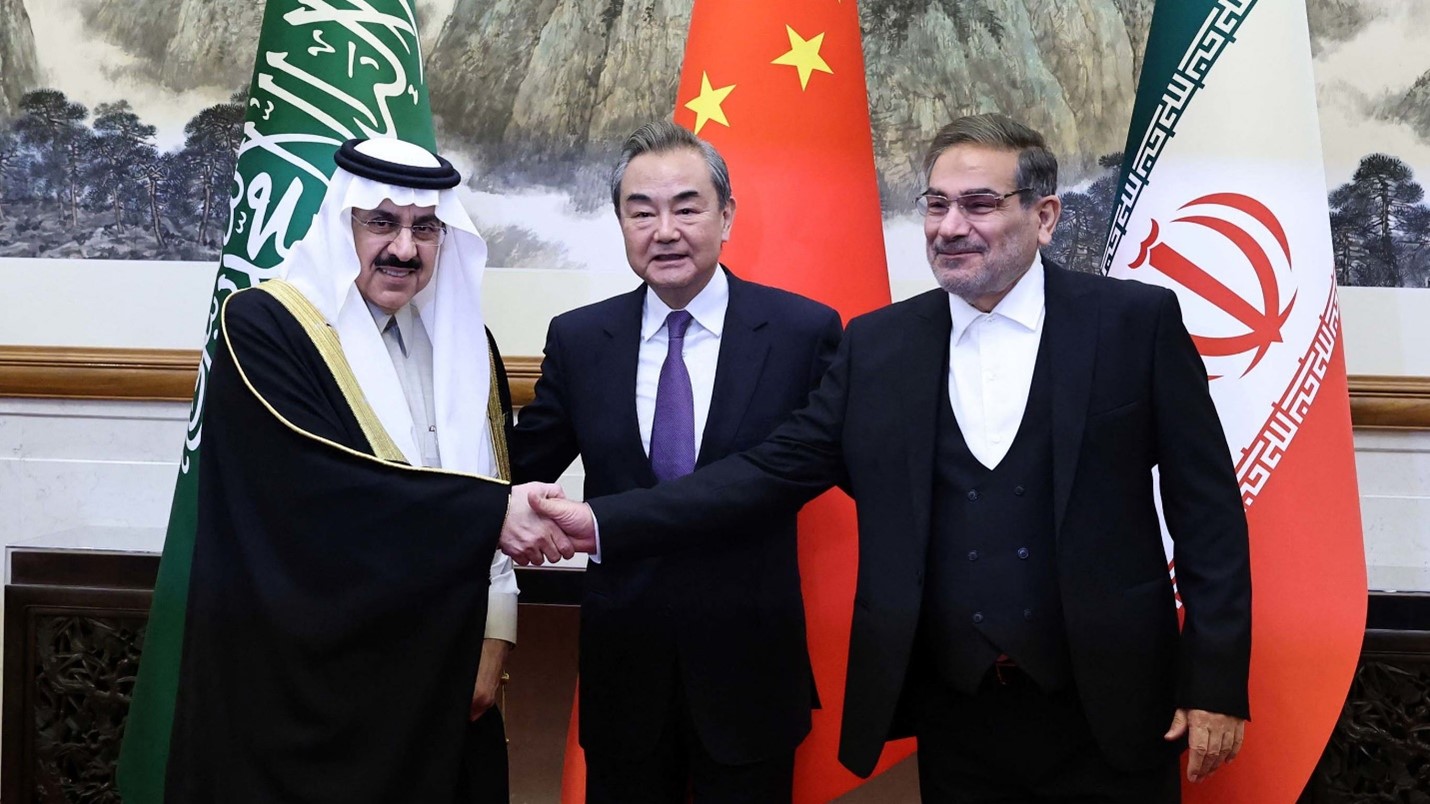
Pakistan’s Geoeconomics
February 23, 2024
Ukraine War – The Collapse of the World Order
February 23, 2024
Pakistan’s Geoeconomics
February 23, 2024
Ukraine War – The Collapse of the World Order
February 23, 2024Ambassador M. Alam Brohi
The Diplomatic Coup by China
The deal between the Kingdom of Saudi Arabia and Iran for rapprochement brokered by China has kindled hopes for the security and stability in the Middle East and the contiguous regions. Tired of their long festering confrontationist policies for dominance in the Middle East, and impelled by internal and international political, economic and strategic compulsions, the leaderships of both countries accepted a deal duly guaranteed by an impartial, powerful and mutually trusted state enjoying political and strategic credibility at the international and regional planes, and having, simultaneously, expanding political and economic cooperation with both countries.

The Chinese successful bid to broker the deal between the two antagonist states is rightly considered a diplomatic coup by China, and a setback to the United States’ position in the region. It also simultaneously marks China’s standing as an international stakeholder in the global affairs. This is bound to exacerbate the US fears that China, through quiet diplomacy and strategic advances, plans to gradually displace it in the greater Asia. The move, in all probability, would accelerate the ongoing confrontation and competition between the two dominant states.
The moot question is whether KSA and Iran have pragmatically appraised the senselessness of their decades-long confrontational policy and sued for good neighborliness in the Middle East, or is it a tactical move to counterweigh the pressure of the other political, economic and strategic compulsions with a view to gaining time to tide over their internal, regional and international problems before revamping their policies for dominance in the Middle East. Only time will tell us. The Saudi-Iran relations have undergone such cyclical periods since the decolonization of the Arab world.
The Arabs and Persians have been entangled in a cobweb of ethnic biases, religious and ideological prejudices compounded by overlapping political and strategic objectives from the Arabian deserts to the Mediterranean shores since long time. The rivalry triggered by the ignominious defeat of Yazdegerd III, the last Sassanid ruler in the seventh century by Arabs kept aglow the Arab-Persian antagonism for the past thirteen centuries undermining the Muslim world. After the Second World War, however, under the influence of the US, this rivalry lied dormant under the thin surface of good neighborliness until the overthrow of Reza Shah Pahlavi in 1979.
The security situation underwent a drastic change during the Khomeini-led regime fueling the fear of the Arab monarchies for the export of the revolution to their region by the determinant Iranian clergy. The minority Shia populations in Arab countries started looking to Iran as their spiritual and ideological centre. The Iraq-Iran war in 1982 supported by Arab monarchies, the Iraqi intrusion into Kuwait, the US attack on Iraq in 1990s and 2003, the Arab Spring, and the devastation of Syria, Libya and Yemen in civil wars aided by Arab monarchs changed the entire strategic landscape of the Arab world dividing it into two antagonist camps under the influence of Saudi Arabia and Iran.
Iran fortified its strategic position in at least five Arab countries including Iraq, Syria, Yemen, Lebanon and the Hamas-ruled Palestine through its strategic presence or its proxy militant organizations such as Hezbollah and Hamas. Iran had learnt a lesson from its earlier war with Iraq to strengthen its own defence resources given the antagonism of the US and its Arab allies. Iran adopted an ambitious “Forward Defence” plan fueling the fears of US and its Arab allies and Israel.
The Iran’s ‘Forward Defense’ plan had many components: to develop indigenous technology and acquire nuclear and missile capability to be used as an umbrella over its other military forces; transform the Iranian Islamic Revolutionary Guards and its Quds militia into a formidable military force; increase their influence with the Shia communities in the Arab countries; recruit and fund proxy militias in the Middle East. Much before the US attack on Iraq in 1990s, Iran began working on its forward defense plan steadfastly enlisting the cooperation of the Arab leaders who were weary of Western interventions in their region and the expansionist designs of Israel. The Shia-Sunni conflict and intra Arab rivalries helped Iran create its sphere of political and strategic influence.
The Hezbollah played a formidable role in Syria against rebels particularly the Free Syrian Army financed by Arab monarchs and trained by another Muslim country to dethrone Bashar ul Asad. The Militia is a power to reckon with in Lebanon and no regime could function there without its support. The Houthis - covertly supported by Iran have withstood the Arab coalition forces. The Hamas has become a thorn in the body of Egypt and Israel. The Shia Iraq is more alarming for the Sunni regimes in the region.
Apparently, the Iranian strategic position in the Middle East is more securely established than at any point in the past. However, the economic sanctions imposed on it by the Western world, the possible collusion of Israel with Arab countries were probably weighing more heavily on the minds of the Iranian leaders. Similarly, the Saudi ruler Prince Muhammad Bin Salman was disillusioned with the stalemate in Yemen war and needed to turn his focus to his ambitious plan of restructuring the economy and modernizing the society of his conservative kingdom. Thus these political and strategic circumstances compelled both countries to sue for peace or a lull in their antagonism. The deal, however, will remain precariously vulnerable to the past distrust and the historic Arab-Persian hostility.
Notwithstanding all this, the Agreement between the two important countries of the region is a good omen for peace and security in the greater Middle East. Both countries will have to take strident confidence building measures to sustain the deal because they have overlapping and mostly conflicting political, economic and strategic interests in the region. The Saudi policy for dominance in the region was earlier resisted by Arab nationalist leaders including Gamal Abdul Nasser, Hafiz ul Asad, Saddam Hussain and Moammar Qadhafi. Yemen with its Aden seaport and the sizeable active Shia population of Yemen descent in Saudi Kingdom’s Najd region has always been prioritized in the Saudi strategic policy. The Aden seaport accounts for 80% of the Saudi Arab’s outbound oil trade.
How the Houthi militia will be accommodated in any power sharing formula, and will Saudi leadership accept Bashar ul Asad, earlier a bête noire, as the legitimate leader of Syria? The Syrian leader recently visited UAE. Will Iran abandon or slow down its quest for nuclear capability being the most sensitive issue of concern for Saudi Arabia and Israel? Will Israel sit back and see an expanding relationship between the two countries without throwing any spanner? These are some crucial questions that weigh on the mind of the Middle East experts.
Pakistan has significant stakes in peace and security in the Middle East and South West Asia given its vital political, economic and strategic interests. Until recently, Pakistan faced an ominous sectarian war widely suspected to be funded by two Muslim countries. We could never be able to have friction-free relations with Iran after the clergy revolution. We were allies of the US and Saudi Arabia in the first Afghanistan war while the US was entangled in bitter hostility with Iran. Even after the withdrawal of the Soviet troops and the US from Afghanistan, our relations with this important neighbour remained hostage to lingering suspicions created by our earlier strategic alliance with the US and Saudi Arabia.
Our support to the Taliban in 1990s and their hostility towards a particular ethnic and sectarian segment of the Afghan population; the brutal murder of the Iranian diplomats in Mazar-e-Sharif; the subversive activities of Jundullah allegedly carried out from across the border kept fueling the Iranian distrust of our commitment to good neighborliness. The strategic conflict between KSA and Iran in the wake of Arab Spring and later the signing of the Joint Comprehensive Plan of Action (JCPOA) between US and Iran; the substantive presence of India in Afghanistan and Iran; our obvious tilt to Saudi Arabia throughout all these years hindered our efforts to improve bilateral relation with Iran.
There are also fears, and legitimate ones, that since the US is fully focused on the Russian-Ukrainian war, it may outsource the containment of China in the greater Middle East to India designing and putting in place a regional alliance like the QUAD and AUKUS which have been doing its bidding in the Indo-Pacific region. This is possible given the strategic objectives of India in the Arabian Sea. The strategic controlling of the Arabian Sea lanes has been the long standing objective of India. Jawaharlal Nehru wanted a greater confederation of the greater Asian countries with India at the steering to replace the British Empire.
We have a difficult and delicate foreign policy task ahead. Our path is strewn with thorns given the misunderstandings of the past and the new challenges thrown to our way by the fast changing geo-political and strategic dynamics. Given the political deadlock; the economic meltdown; the mounting terrorist attacks on the country’s physical security and the lack of synergy between the state institutions, these challenges seem formidable. We feel besieged from within. We have to break this siege.

The Author
